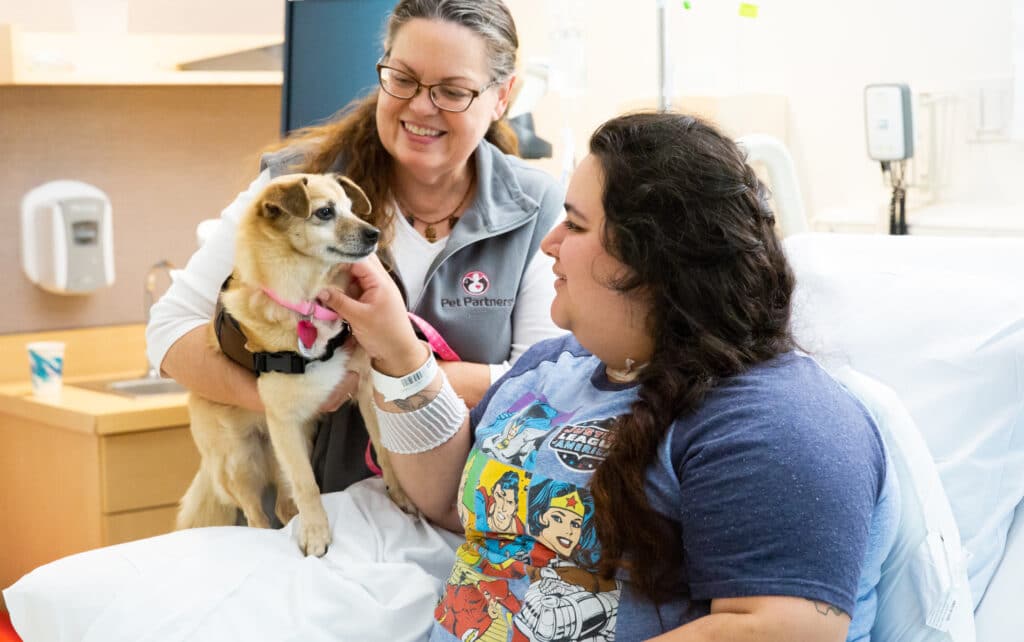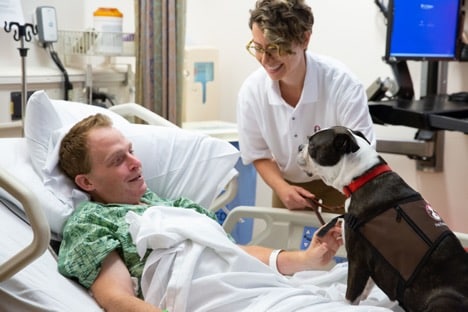



We know that our canine companions can lighten the mood, make us laugh, and generally improve our quality of life. But is it true that they can actually decrease pain? The growing body of research on AAI supports the use of animal-assisted activities and animal-assisted therapies for pain relief. Whether you’re a patient, a handler, or a healthcare worker, this information can be useful to your efforts—check out how dogs have been proven to “paws” pain.
 Ample research supports the use of therapy animals to alleviate pain in adult and pediatric clients who have recently undergone surgical procedures [1]. One study researched the effect of therapy animals on patients who had undergone a total hip or total knee replacement. Patients who interacted with a therapy dog prior to physical therapy rated their pain as lower than patients who underwent typical post-surgical protocols [2].
Ample research supports the use of therapy animals to alleviate pain in adult and pediatric clients who have recently undergone surgical procedures [1]. One study researched the effect of therapy animals on patients who had undergone a total hip or total knee replacement. Patients who interacted with a therapy dog prior to physical therapy rated their pain as lower than patients who underwent typical post-surgical protocols [2].
Mobilizing the operated extremity soon after surgery has been proven to increase pain control in patients with total joint replacements. This presents a perfect opportunity to introduce therapy dogs into a rehabilitation program [3]. One study found that patients were less likely to refuse therapy if a therapy dog was present (7% refusal with therapy dog present, compared to a historical 28% refusal rate) [4]. Patients working with a therapy dog also took more steps on average than patients who worked with a therapist alone. Therapy dogs may motivate clients to participate in early mobilization and play an important role in helping patients manage their pain postoperatively.
 This decrease in post-operative pain can have far-reaching benefits. Interest is growing in alternative pain management options that could decrease use of opioid and other medication-based methods. Animal-assisted interventions may be just the tool we need to help patients manage their pain in new ways.
This decrease in post-operative pain can have far-reaching benefits. Interest is growing in alternative pain management options that could decrease use of opioid and other medication-based methods. Animal-assisted interventions may be just the tool we need to help patients manage their pain in new ways.
In one study, patients who had recently undergone a total joint replacement used almost 50% less pain medication when AAI was used as an adjunctive intervention for post-operative pain control [5]. A follow-up study utilizing AAI after total joint replacement (some using Pet Partners registered teams) was shown to support this reduction in pain medication use [6]. Individuals who received AAI used significantly less pain medication (15.32 mg vs. 21.16 mg) than patients who did not. This study also noted that the more frequently a patient received AAI, the more their pain medication usage decreased.
Animal-assisted interventions are a valuable option for healthcare providers and administrators to consider. They can be provided on a volunteer basis at minimal cost to the facility, decrease pain, increase patient satisfaction, and may decrease the economic impact of opioid use.
Palliative care is specialized medical care for people with a serious illness that focuses on pain relief, stress reduction, and quality of life improvement for patients and their families [7]. Utilizing therapy dogs in this setting is an excellent way to increase comfort while decreasing anxiety and pain. Patients receiving palliative care reported that they felt “distracted” by their pain in the presence of a therapy dog, stating “my pain feels better” and “my discomfort is less.” [8] In a field where the purpose is to relieve discomfort and improve quality of life, AAI can be extremely beneficial.
This study also found that medical staff stress was reduced when the therapy dog was present. Talk about walking two dogs with one leash!
 Therapy dogs are extremely beneficial for individuals experiencing chronic pain, who often cannot escape from their symptoms using traditional medicine and experience symptoms for at least six months [9]. In one study, 34% of patients with fibromyalgia (a chronic pain condition that affects 2%-3% of Americans) reported pain relief after interacting with a therapy dog while waiting for a doctor’s appointment, compared to 4% of patients in a waiting room without the dog [10]. In an outpatient chronic pain clinic, patients were given the opportunity to interact with Wheatie, a 5-year-old Wheaten terrier therapy dog, prior to their appointment [11].
Therapy dogs are extremely beneficial for individuals experiencing chronic pain, who often cannot escape from their symptoms using traditional medicine and experience symptoms for at least six months [9]. In one study, 34% of patients with fibromyalgia (a chronic pain condition that affects 2%-3% of Americans) reported pain relief after interacting with a therapy dog while waiting for a doctor’s appointment, compared to 4% of patients in a waiting room without the dog [10]. In an outpatient chronic pain clinic, patients were given the opportunity to interact with Wheatie, a 5-year-old Wheaten terrier therapy dog, prior to their appointment [11].
Clinically meaningful pain relief occurred in 22.6% of the patients who spent time with Wheatie. While this may seem a small percentage, it’s important to remember that therapy dog visits are not intended to be used as a primary pain management technique. However, this research shows that they can offer positive benefits as a complementary therapy.
This area deserves future research to discover exactly why this method of pain relief is so effective. Some theories suggest that the distraction from pain and emotional bonds with animals lead to perceived decrease in pain, or that the complex chemical reactions that occur during interactions with animals have an analgesic effect [12].
Regardless of the method of action, using therapy animals as part of pain management is a reliable method that provides relief of symptoms on the patient level, increased client satisfaction scores on the administrative level, and an alternative to opioids. This area should continue to be advocated for as a complementary therapy, and deserves more research to expand the knowledge base surrounding AAI.
If you are a healthcare provider interested in bringing therapy animals into your facility, learn more about how to start a therapy animal visiting program.
If you are interested in becoming a handler so that you and your animal can bring pain relief to facilities near you, get the details on how to become a registered therapy animal team with Pet Partners.
References